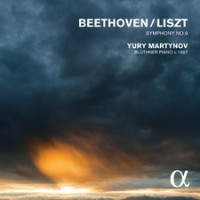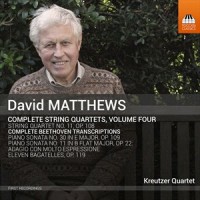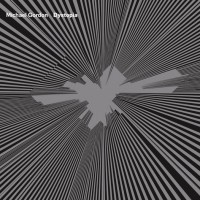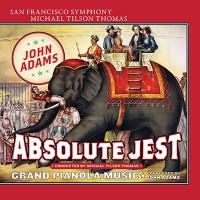(Dis)Arrangements 7: Beethoven
|
Grant Chu Covell [March 2016.]
Ludwig van BEETHOVEN: Symphony No. 9, “Choral,” Op. 125 (1824; arr. Franz LISZT, 1864). Yury Martynov (pno). Alpha 227 (1 CD) (http://www.outhere-music.com/) Perhaps it’s the captivating Blüthner piano which rings with a warm, tidy sound, bestowing intimacy onto what could be an impossible transcription, but this Ninth is fascinating, hugely musical, a testament to Beethoven and Liszt’s combined brilliance. Stand up Martynov’s performance next to an acceptable orchestra and the ca. 1867 piano wins on clarity and command. There are effects in the original finale which can’t easily be imitated, but Liszt cultivates a persuasive argument, perfectly suited to the piano; Martynov shapes it expertly. Sometimes rhythms are maintained over held choral tones, elsewhere an idea is transposed an octave so that it emerges distinctly. I often repeated just the first and second movements because in Liszt’s retelling there is so much to hear and savor. Even when you know what’s going to happen, the Blüthner (lovingly restored in 2012-13) adds personality which never fails to surprise and delight. This would be the fifth disc in Martynov’s series of Liszt’s Beethoven Symphonies transcriptions. I’ve come in at the end, but at least don’t have to wait to explore the others.
“Beethoven Explored, Vol. 6.” Ludwig van BEETHOVEN: Symphony No. 3, “Eroica,” Op. 55 (1803; arr. unknown, 1807). Peter Sheppard Skærved (vln), Dov Scheindlin (vla), Neil Heyde (vlc), Aaron Shorr (pno). Metier MSVCD 2008 (1 CD) (http://www.divineartrecords.com/). We do not know who crafted this piano quartet arrangement of Beethoven’s Third. Sheppard Skærved considers this mystery in absorbing detail. Subtle texture choices (e.g.: the three strings imitate the horns in the Scherzo) and that errors in the symphony’s original orchestral parts were not duplicated here suggest a musician with access to the then-unpublished full score, perhaps someone with first-hand involvement in the Eroica’s premiere. Even if symphonic arrangements may seem commonplace today, at the time of the Eroica’s creation they were unusual. This particular one appeared a few years after the symphony’s completion. Could Beethoven have arranged it himself? Let us hope not, as this is a lumbering, overcrowded transcription, lacking the delight of the original’s dramatic vigor. It does not represent itself as a piano quartet, but as a sturdy delivery of complex ideas to keep four musicians busy. This perhaps led to a dilemma for the players: Should they consider this a proper piano quartet (which might be a struggle) or emulate the symphony (which it feels like they try).
“David Matthews Complete String Quartets. Vol. 4.” Ludwig van BEETHOVEN: Eleven New Bagatelles, Op. 119 (1822; arr. David MATTHEWS, 2013); Piano Sonata No. 28, Op. 101 (1816; arr. MATTHEWS, 1997); Adagio con molta espressione from Piano Sonata No. 11, Op. 22 (1800; arr. MATTHEWS, 1980). David MATTHEWS: Diabelli Variation (1975; arr. 2011); String Quartet No. 11, Op. 108 (2007-08). Kreutzer Quartet: Peter Sheppard Skærved, Mihailo Trandafilovski (vln), Morgan Goff (vla), Neil Heyde (vlc). Toccata Classics TOCC 0318 (1 CD) (http://www.toccataclassics.com/). Beethoven’s piano music is so familiar and perfected as is, that these quartet arrangements meet with immediate suspicion. It is possible after many airings to hear No. 4, the slowest of the Op. 119 Bagatelles, as definitive in this transcription. But then an idiomatic piano gesture falls short, such as the the initial highly placed turn and later close-position accompaniment of No. 3, or entirety of the most mercurial of them all, the elegantly diminutive No. 10. I wanted to like these, but kept finding flaws. The A-major sonata, Op. 101, is like a family member appearing in borrowed ill-fitting clothes. Perhaps we learn that Beethoven wrote idiomatically, and, more importantly, that his innovative piano writing doesn’t easily carry over to quartet. I sincerely appreciate Matthews’ admiration of his sources, however, I did not learn more about Beethoven. The release’s most interesting item is Matthews’ investigative and restless Eleventh, a series of variations on Op. 119, No. 8. His own two-minute Diabelli Variation is easy to miss. His quartets do not stray markedly from developed tonality, “along a path similar to that taken by Tippett and Britten; one rooted in the Viennese Classics.” The structure and design also reflect older models, with total effects, balances and contrasts that are reasonably conventional. As much as I wanted to revel in the Beethoven, I enjoyed Matthews’ own work more.
Michael GORDON: Dystopia (2007)1; Rewriting Beethoven’s Seventh Symphony (2006)2. Los Angeles Philharmonic1, David Robertson1 (cond.), Bamberger Symphoniker2, Jonathan Nott2 (cond.). Cantaloupe Music CA21105 (1 CD) (http://www.cantaloupemusic.com/). Dystopia tears back the curtain onto an outlandishly grand pulsing landscape. Gordon genially assaults us with compounded dance rhythms and snippets of tunes, an outrageous Revueltas or Ives, though I suspect the influence lies closer to funky film scores from the 1970s. Thirty minutes in all, Dystopia begrudgingly calms about eight minutes in, but the thumping percussion, climbing piccolos and electric bass soon ratchet back up. This frenetic minimal canvas rich with chromatic pentatonicism will snag fans or antagonize detractors right from the very start. As a dystopia, it’s not actually so bad. Working in continued partnership with videographer Bill Morrison, this “film symphony” was inspired by Los Angeles. I suspect it was provisionally titled Utopia, but Gordon is too clever for that. Gordon’s Beethoven riff is precisely that. Recognizable swatches from the Seventh undergo manipulation according to methods on display in Dystopia. Press your nose to the glass and see how the sausage is made. The opening movement features the original chords on perpetual repeat slowly succumbing to smearing glissandos. Given that the original’s slow movement is all about rhythm, Gordon avoids the easiest treatment, instead exploring the movement’s stepwise harmonies. Often, it’s like hearing two recordings of the same piece playing at the same time. The Beethoven is always there but gradually pupates into Gordon. Both exuberant and convincing recordings are from the world premieres (12 Jan. 2008 for Dystopia and 30 Sep. 2006 for Rewriting).
John ADAMS: Absolute Jest (2013)1; Grand Pianola Music (1982)2. St. Lawrence String Quartet1: Geoff Nuttall, Scott St. John (vln), Lesley Robertson (vla), Christopher Costanza (vlc); Orli Shaham2, Marc-André Hamelin2 (pno), Synergy Vocals2: Micaela Haslam, Joanna Forbes L’Estrange (sop), Heather Cairncross (alt); San Francisco Symphony, Michael Tilson Thomas1, John Adams2 (cond.). SFS Media SFS 0063 (1 SACD) (http://www.sfsymphony.org/). Absolute Jest is riddled with inside jokes for Beethoven fanatics. The opening takes cues from the start of the Ninth and elsewhere, but the treatment reflects Adams’ particular evolution from a conventional minimalist to a far more intricate and Romantic composer. Playfulness is on evidence throughout, including a trailing-away Ivesian ending. Adams apparently rewrote the first third thinking it was too pedantic. He balances quartet and orchestra through alternating density of accompaniment. Also, the quartet is often first to quote distinctive bits from Opp. 131, 135 and the Grosse Fuge. I’ve only experienced the work through this recording, but suspect this “colossal twenty-five-minute scherzo” could be played just slightly more recklessly and energetically. Clued in by the notes, I hear the Beethoven bits in Grand Pianola Music and am surprised I had never noticed them before. Looking past the three women’s voices, there are piano cascades and orchestral rejoinders that could only have been inspired by the Emperor concerto. Adams describes a dream realized perfectly in Grand Pianola Music: “…while driving down Interstate Route 5, I was approached from behind by two long, gleaming, black stretch limousines. As the vehicles drew up beside me they transformed into the world’s longest Steinway pianos… Screaming down the highway at ninety miles an hour, they gave off volleys of B-flat and E-flat major arpeggios.” At the time, Grand Pianola Music was an affront; in retrospect we see Adams had worked out a vocabulary that would sustain him.
[More (Dis)Arrangements, Grant Chu Covell]
[Previous Article:
String Theory 18: Bundled Quartets and a few Trios]
[Next Article:
Utopian Listening: Reinvigorating Nono in America]
|




